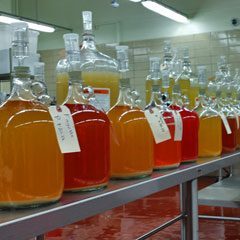From tasting rooms, to store shelves, the popularity of hard cider is growing. Apple growers and researchers in Wisconsin have created a new guide to help apple growers—and cider makers—select the best apple varieties.
The Growing Hard Cider Industry
“Over the past 5 years, hard cider has been the fastest-growing craft beverage in the U.S.,” said Michelle Miller with Wisconsin’s Center for Integrated Agricultural Systems (CIAS). “With increasing prices for cider apples, less focus on the fruit’s cosmetic appearance, and new community ties to a local beverage, the emerging cider industry offers opportunities for increasing economic, environmental, and social sustainability in the North Central region. Unfortunately, inadequate information about cider apple varieties and market preferences limit growers’ ability to tap cider’s potential.”
Miller has been working with a participatory research team to understand the growing hard cider industry. They surveyed hard cider makers to find opportunities with an eye on rural development. They looked at industry trends, apple sourcing, marketing, and distribution. Building on Matt Raboin’s previous SARE grant on apple varieties for hard cider, Miller received a $29,999 NCR-SARE Partnership Program grant in 2017 to work with local apple growers. The team identified 40 apple varieties with potential for sustainable cider production.
The team assessed the cider properties of each variety through laboratory and sensory evaluation. They identified market preferences through focus group research and cooperation with the Seed to Kitchen Collaborative, a University of Wisconsin program that connects plant breeders to farmers and chefs.
Tips for Producers
It turns out there are a number of cider apples that fall in the mid-range of flavor, according to Miller. Some notable findings from the team's analysis include:
- Tasters preferred ciders that were perceived as sweet or balanced between sweetness and acidity. Liberty, Kingston Black, Unknown 1, Tremlett’s Bitter and Steele Red were the favorite varieties, in addition to the check cider. Liberty CH was the best overall, Old Nonpariel had the best mouthfeel, and Cap of Liberty was the most intense. Four apple varieties had the highest perceived strength/alcoholic content: Golden Russet, Thornberry, Dabinett, and Unknown 2. The least favorite varieties—Priscilla, Somerset Redstreak, and Red Delicious—were perceived as bitter. More information about varieties can be found on the team's Comparing Apples to Apples webpage.
- Growers who make their own cider may want to choose varieties from this cohort to make a base juice, and then choose apples with a more distinct flavor profile to blend and enhance the finished product.
- Apples with a higher intensity flavor may be worth growing, even if the trees don’t produce as much fruit as other varieties.
- Apple flavor is highly variable from year to year, orchard to orchard, so think of the project results as a snapshot of apples grown in the Upper Midwest, 2017.
- Growers should lab test apple juice and use the findings to market their juice if they are not making cider themselves. In this way, they can communicate quality and value to cider makers, and negotiate higher price points for their products.
Dig Deeper
The global cider market was valued at $10,667 million in 2016 and is projected to reach $16,252 million by 2023 (Allied Market Research 2018). The "Comparing Apples to Apples" report provides hard cider apple variety information. Read more at the Comparing Apples to Apples webpage.
This SARE-supported project laid the groundwork for a larger four-state effort to investigate craft cider supply chains. The new project is a $500,000 USDA-AFRI grant project called "Apple to Glass: Improving orchard profitability through developing regional craft ciders." It brings together industry knowledge from Washington State, Michigan, Vermont, and Wisconsin.
View a video of Matt Raboin and Michelle Miller presenting their research.
View Related SARE Grants:
- Comparing Apples to Apples: Participatory Research for Artisanal Cider Producers (ONC17-030)
- Apples for Artisanal Cider: Understanding the Characteristics of Single Varietals (FNC16-1053)
